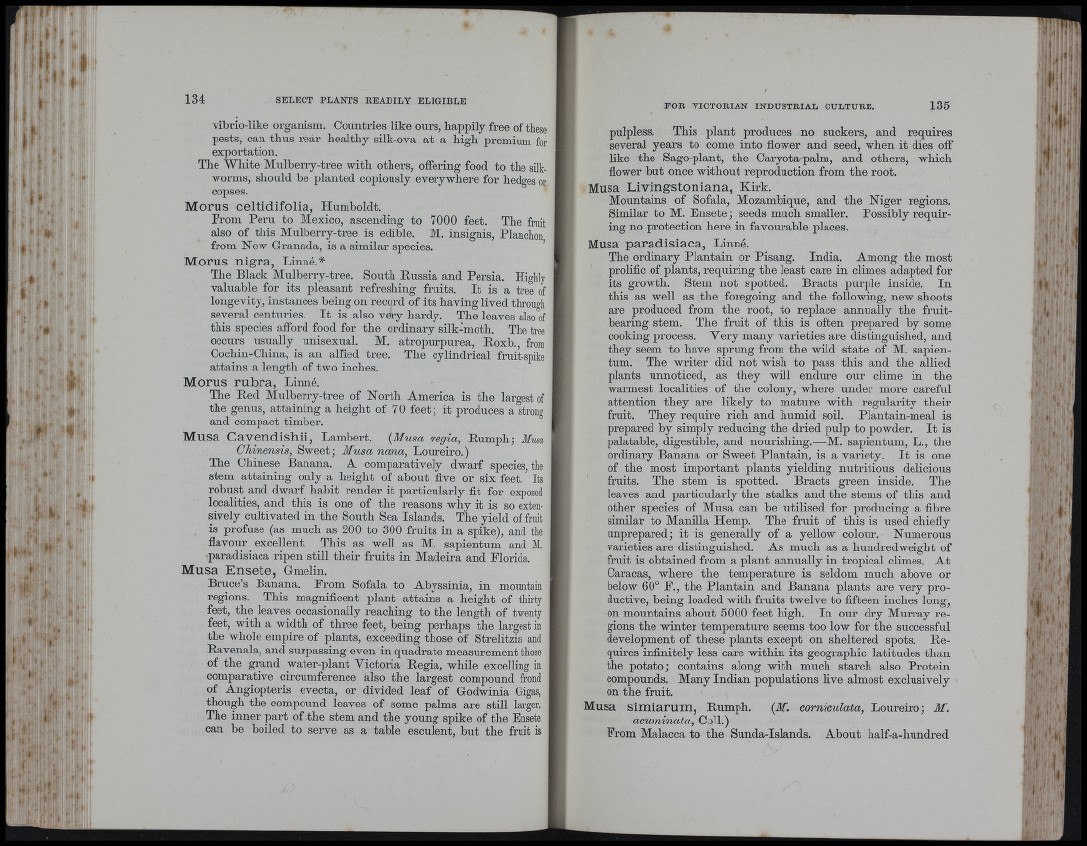
, 'I Mks' 'i »
vibrio-like organism. Countries like onrs, happily free of these
pests, can thus rear healthy silk-ova at a high premium for
exportation.
The White Mulberry-tree with others, offering food to the silkworms,
should be planted copiously everywhere for hedges or
copses.
Morus celtidifolia, Humboldt.
From Peru to Mexico, ascending to 7000 feet. The fruit
also of this Mulberry-tree is edible. M. insignis, Planchon
from New Granada, is a similar species. '
Morus nigra, Linné.*
The Black Mulberry-tree. South Eussia and Persia. Highly
valuable for its pleasant refreshing fruits. I t is a tree of
longevity, instances being on record of its having lived througli
several centuries. I t is also very hardy. The leaves also of
this species afford food for the ordinary silk?moth. The tree
occurs usually unisexual. M. atropurpúrea, Eoxb., from
Cochin-China, is an allied tree. The cylindrical fruit-spike
attains a length of two inches.
Morus rubra, Linné.
The Eed Mulberry-tree of North America is the largest of
the genus, attaining a height of 70 feet; it produces a strong
and compact timber.
Musa C aV G n d isb ii, Lambert. {Musa regia, Enmph; Mma
Chinensis, Sweet; Musa nana, Loureiro.)
The Chinese Banana. A comparatively dwarf species, the
stem attaining only a height of about five or six feet. Its
robust and dwarf habit render it particularly fit for exposed
localities, and this is one of the reasons why it is so extensively
cultivated in the South Sea Islands. The yield of fruit
is profuse (as much as 200 to 300 fruits in a spike), and the
flavour excellent. This as well as M. sapientum and M,
■paradisiaca ripen still their fruits in Madeira and Florida.
Musa Ensete, Gmelin.
Bruce’s Banana. From Sofala to Abyssinia, in mountain
regions. This magnificent plant attains a height of thirty
feet, the leaves occasionally reaching to the length of twenty
feet, with a width of three feet, being perhaps the largest in
the whole empire of plants, exceeding those of Strelitzia and
Eavenala, and surpassing even in quadrate measurement those
of the grand water-plant Yictoria Eegia, while excelling in
comparative circumference also the largest compound frond
of Angiopteris evecta, or divided leaf of Godwinia Gigas,
though the compound leaves of some palms are still larger.
The inner part of the stem and the young spike of the Ensete
can be boiled to serve as a table esculent, bnt the fruit is
I
pulpless. This plant produces no suckers, and requires
several years to come into flower and seed, when it dies off
like the Sago-plant, the Caryota-palm, and others, which
flower but once without reproduction from the root.
Musa Livingstoniana, Kirk.
Mountains of Sofala, Mozambique, and the Niger regions.
Similar to M. Ensete ; seeds much smaller. Possibly requiring
no protection bei'e in favourable places.
Musa paradisiaca, Linné.
The ordinary Plantain or Pisang. India. Among the most
prolific of plants, requiring the least care in climes adapted for
its growth. Stem not spotted. Bracts purple inside. In
this as well as the foregoing and the following, new shoots
are produced from the root, to replace annually the fruit-
hearing stem. The fruit of this is often prepared by some
cooking process. Yery many varieties are distinguished, and
they seem to have sprung from the wild -state of M. sapientum.
The writer did not wish to pass this and the allied
plants unnoticed, as they will endure our clime in the
warmest localities of the colony, where under more careful
attention they are likely to mature with regularity their
fruit. They require rich and humid soil. Plantain-meal is
prepared by simply reducing the dried pulp to powder. I t is
palatable, digestible, and nourishing.—M. sapientum, L., the
ordinary Banana or Sweet Plantain, is a variety. I t is one
of the most important plants yielding nutritious delicious
fruits. The stem is spotted. Bracts green inside. The
leaves and particularly the stalks and the stems of this and
other species of Musa can be utilised for producing a fibre
similar to Manilla Hemp. Tbe fruit of tbis is used chiefly
unprepared; it is generally of a yellow colour. Numerous
varieties are distinguished. As much as a hundredweight of
fruit is obtained from a plant annually in tropical climes. At
Caracas, where the temperature is seldom much above or
below 60° F., tbe Plantain and Banana plants are very productive,
being loaded with fruits twelve to fifteen inches long,
on mountains about 5000 feet high. In onr dry Murray regions
tbe winter temperature seems too low for the successful
development of these plants except on sheltered spots. Ee-
quires infinitely less care within its geographic latitudes than
the potato; contains along with much starch also Protein
compounds. Many Indian populations live almost exclusively
on the fruit.
Musa simiarum, Enmph. {M. corniculata, Loureiro; M.
acuminata, Coil.)
From Malacca to the Sunda-Islands. About half-a-bnndred
;l .
; î
f !
b I
■ Í ' Atl
'A : II
bJ j
I
Ay1